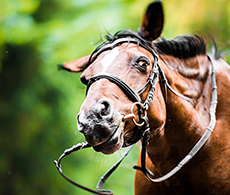
Horse headshaking: what every horse owner should know
Get the lowdown on this distressing condition. Find out what causes headshaking, when to call your vet, and potential treatment options to keep your horse as comfortable as possible.
Headshaking in horses can be difficult to diagnose, but it can have a huge impact on the daily life and ridden careers of horses. This syndrome can also be seasonal, with symptoms worsening in the spring and summer. Dr Veronica Roberts, a world-leading expert on horse headshaking, shares more detail on this condition.
What causes headshaking in horses?
Headshaking in horses is also known as trigeminal-mediated headshaking and is different from head-tossing, which is a normal part of equine body language. Trigeminal-mediated headshaking is a complex condition, with the exact cause still unknown. Experts have identified that it affects the trigeminal nerve, which runs across the face and over the nose of horses. In this condition, the nerve becomes overly sensitised, causing neuropathic (shooting and burning) pain.
From research on humans, we know that neuropathic pain can create a range of unpleasant sensations from pins and needles to sharp pains like an electric shock. It’s suspected this is also the case in horses. Horses can shake their heads in an attempt to relieve the pain. While previously this might have been blamed on bad behaviour, we now know that’s not the case.
Which horses are affected by headshaking?
Headshaking can affect any horse or pony and there doesn't seem to be any link to specific breeds. The age of onset is usually around six, but the condition can develop at any age. Dr Roberts’ research indicates that headshaking can be a problem in 4.6% of the UK equine population, or around 44,000 horses. Within these affected horses, the majority may be diagnosed with trigeminal-mediated headshaking.
Some horses show seasonal headshaking, or the signs increase when horses are out hacking and exposed to pollen from trees, rapeseed and hedgerows. The link to the environment isn’t yet clear, but we do know this is not an allergy. In around 5% of diagnosed horses, the condition spontaneously resolves itself.
Symptoms of headshaking
Some of the classic clinical signs of trigeminal-mediated headshaking include:
- Vertical headshaking
- Sharp vertical flicks
- Signs of nasal irritation
- Rubbing of the nose
- Twitching lips
Horses' symptoms often worsen during exercise, while others are so badly affected that they will show signs of headshaking even when resting. Both sides of the face are affected equally.
‘If your horse is headshaking at rest, they will be extremely uncomfortable and need support from a specialist as soon as possible,’ says Dr Roberts. Horses with severe headshaking may become dangerous to ride.
For horses that headshake when exercised, specialists will usually request a range of videos to grade the level of headshaking in different situations including lunging and ridden work.
How is headshaking diagnosed?
Headshaking is a relatively uncommon condition and it’s likely that your vet will refer you to a specialist for detailed testing and diagnosis. Dr Roberts notes that if headshaking is suspected, it’s usually best to request a referral sooner rather than later, otherwise you may end up paying for unnecessary testing and potentially the wrong kinds of treatment.
Diagnosis of headshaking is complex. As there are no specific tests as yet, part of the investigation will involve excluding all other potential conditions.
Treatment for headshaking
Dr Roberts recommends a range of scientifically proven treatments for headshaking, although the response to these can vary from horse to horse.
Nose net
This non-invasive and cost-effective treatment can offer relief to many horses diagnosed with headshaking. Dr Roberts’ research found that nose nets helped provide up to 70% relief in 25% of affected horses. Trying a nose net is usually the first treatment option and if your horse responds, it’s likely that their headshaking is trigeminal-mediated. Usually, the trial of three different nose nets and a full face mask is recommended as some horses may respond to one brand, but not to another.
EquiPENS™
Dr Roberts has pioneered the use of EquiPENS™ for the treatment of headshaking. The horse is sedated before receiving electrical nerve stimulation over the face. This treatment will be given three times over the course of around three weeks. So far, more than 50% of headshaking horses will go into remission after receiving an initial course of treatment. There are now a range of vet centres offering this treatment across the UK, including B&W Equine, where Dr Roberts is based in the clinical part of her University of Bristol role.
Other treatment options
If nose nets and EquiPENS™ treatments don’t offer any relief, there are a range of other options that may be offered on a case-by-case basis. These include pharmaceuticals, eye drops, electrolyte therapy, electroacupuncture and surgery. Magnesium supplements also seem to help some horses, and this is a cost-effective option that owners can try at home.
Download our ‘Practical guide to headshaking’ so that you have the lowdown on this condition easily to hand and can share it with your riding friends.



